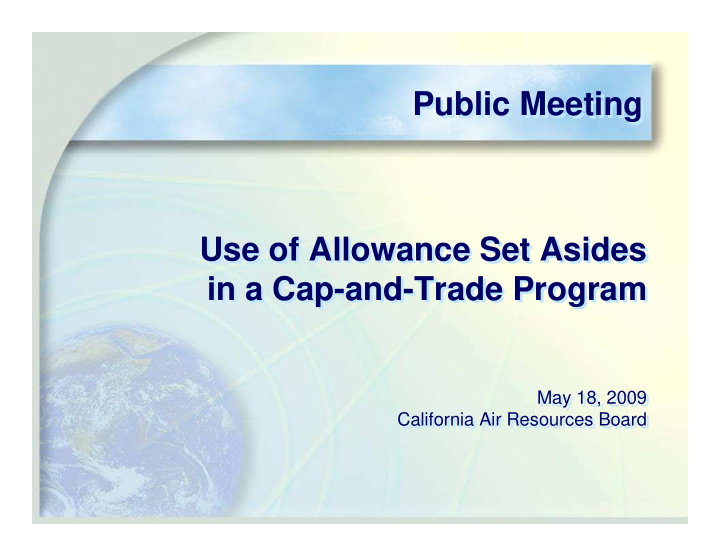



Public Meeting Public Meeting Use of Allowance Set Asides Use of Allowance Set Asides in a Cap-and-Trade Program in a Cap-and-Trade Program May 18, 2009 May 18, 2009 California Air Resources Board California Air Resources Board
California Cap-and-Trade California Cap-and-Trade Rulemaking Timeline Rulemaking Timeline • Focus in 2009: work through implications of different issues and policy decisions • Focus in 2010: finalize program design and regulatory language • Late 2010: Board consideration of cap-and- trade regulation • Extensive public process throughout 2
Purpose of Meeting Purpose of Meeting • Discuss approaches for the potential use of set-asides in a California cap-and-trade program • Stakeholders are asked to provide written comments on this topic to ARB by June 12th (to ccworkshops@arb.ca.gov ) 3
Outline for Today’s Presentation Outline for Today’s Presentation • Define Allowance Set-Aside • Policy and Design Considerations of Allowance Set-Aside Program • Examples • Discussion 4
Meeting Agenda Meeting Agenda 1:30-1:35 Introductions and Opening Remarks 1:35-2:00 Staff Presentation 2:00-4:20 Roundtable Discussion and Questions and Answers 4:20-4:30 Closing Remarks and Next Steps 5
What Are Set-Asides? What Are Set-Asides? Set-asides are a pool of allowances reserved for specific purposes, such as: – Rewarding early action – Incentives for energy efficiency, water efficiency and land use planning – Recognition of voluntary emissions reductions – Recognize projects that reduce emissions in low-income or disadvantaged communities 6
Policy Considerations Policy Considerations • Can allowance set-asides provide a useful tool for achieving AB 32 goals? • Would this type of incentive and recognition approach achieve more than alternative approaches (e.g., monetary incentives, energy efficiency programs)? 7
Policy Considerations (2) Policy Considerations (2) • Would allowance set-asides strengthen or complicate the cap-and-trade program? – Would set asides raise the cost of remaining allowances? – Would set aside requirements raise compliance costs to project proponents or capped sources enough to discourage their use? 8
Approaches for Using Approaches for Using Set-Aside Allowances Set-Aside Allowances • Example : Retire set-aside allowances on behalf of reductions achieved by qualifying projects, such as voluntary renewables • Example : Distribute allowances to those taking action based on reductions achieved – Giving allowances would recognize emission reduction activities – Value would help recoup project investment – Consideration: Similar incentives might be achieved through distribution of revenue from allowance auctions 9
Design Considerations Design Considerations for Set-Aside Programs for Set-Aside Programs General principles for calculating reductions –Methods must be measurable, accurate and replicable –Emission reductions must be verified • Periodic review to ensure reductions continue over life of the project –Periodic review of methodologies 10
Design Considerations Design Considerations for Set-Aside Programs (2) for Set-Aside Programs (2) Should allowance set-asides be based on specific considerations? – Permanent design feature or decline over time – Geographic • Within the State • Within the WCI region • No limits – Achievement of co-benefits 11
Design Considerations Design Considerations for Set-Aside Programs (3) for Set-Aside Programs (3) What eligibility requirements should apply to set-asides projects? –Examples: • Methodology that prevents potential double counting • Specification of qualifying types of projects based on quantification criteria • Applicability of projects that may be funded through other revenue streams 12
An Existing Set-Aside Program An Existing Set-Aside Program Regional Greenhouse Gas Initiative (RGGI) – Limited to voluntary renewable energy projects – Sets aside allowances for every MWh sold into voluntary market – Retires allowances from the cap to account for these voluntary purchases 13
Set-Aside Program Concepts Set-Aside Program Concepts Example 1: Voluntary Renewable Energy Retire allowances associated with GHG reductions from a renewable energy generation project • Advantages: – Additional reductions from capped sectors • Disadvantages: – Fewer allowances to obligated entities in the cap – Could increase allowance price depending on extent of set-aside program • Unknown: How much of a demand in new renewable generation would set asides encourage 14
Set-Aside Program Concepts (2) Set-Aside Program Concepts (2) Example 2: Energy Efficiency • Allowances provided to project proponent for energy efficiency projects that help achieve electricity sector goals • Allowances are sold back into the market to help defray costs of the project 15
Set-Aside Program Concepts (3) Set-Aside Program Concepts (3) Example 2: Energy Efficiency (cont’d.) • Advantages: – Potential for greater penetration of economy- wide energy efficiency – Supports California energy efficiency goals • Disadvantages: – Allowance prices are variable and may not adequately recover investment – Potentially high administrative/tracking costs 16
Set-Aside Program Concepts (4) Set-Aside Program Concepts (4) Example 2: Energy Efficiency (cont’d.) • Unknown: –May be difficult to adequately quantify and verify reductions –Who would get credits – multiple participants and funding sources 17
Key Questions for Key Questions for Stakeholder Discussion Stakeholder Discussion • Are set-asides an appropriate mechanism for achieving AB 32 policy goals? • What other mechanisms may be preferable to incentivize reductions? • How should set-aside allowances be distributed? 18
Key Questions for Key Questions for Stakeholder Discussion (2) Stakeholder Discussion (2) • What specific eligibility criteria could be imposed, consistent with AB 32 goals? • What program limits should be considered (e.g., quantity, geographic location, other)? 19
Team Leads for Cap & Trade Team Leads for Cap & Trade Rulemaking Rulemaking Sam Wade, Mary Jane Coombs Cap setting and allowance distribution Ray Olsson Market operations and oversight Brieanne Aguila Offsets and cap-and-trade project manager Claudia Orlando Electricity Joshua Cunningham Transportation Manpreet Mattu Reporting Energy efficiency Bruce Tuter, Mihoyo Fuji Industrial sectors Karin Donhowe Natural gas for residential and commercial Mihoyo Fuji Marginal abatement costs and leakage related issues David Kennedy, Stephen Impact analyses (environmental, economic, Shelby, Barbara Bamberger, localized, small business, public health) Mihoyo Fuji, Jeannie Blakeslee, 20 Judy Nottoli, Jerry Hart
For More Information… For More Information… • ARB’s Cap-and-Trade Web Site – http://www.arb.ca.gov/cc/capandtrade/capandtrade. htm • To stay informed, sign up for the Cap-and-Trade listserv: – http://www.arb.ca.gov/listserv/listserv_ind.php?listna me=capandtrade • Western Climate Initiative – http://www.westernclimateinitiative.org 21 21
Recommend
More recommend